
Guests
- Doug Peacockwilderness activist and grizzly bear researcher. He is the author of several books on grizzly bears. He was the model for the character Hayduke in Edward Abbey’s The Monkey Wrench Gang.
Naturalist, adventurer and writer Doug Peacock talks about the Vietnam War, how grizzly bears saved his life, the wilderness, his friendship with the late writer Edward Abbey and more. One of Abbey’s most famous characters, Hayduke, from his book The Monkey Wrench Gang, was based partly on Doug Peacock. [includes rush transcript]
Transcript
AMY GOODMAN: In this segment, we stay in Montana for part two of my interview with the naturalist, adventurer, writer, Doug Peacock, the husband of our last guest Andrea Peacock. His books include Grizzly Years: In Search of the American Wilderness.
I first interviewed Doug and Andrea last month in Bozeman, Montana, about their involvement in the fight to protect the state’s grizzly bears and their friendship with the late writer Edward Abbey. One of Abbey’s most famous characters, Hayduke, from his book The Monkey Wrench Gang, was based on Doug Peacock.
Well, after the Democracy Now! broadcast ended in Bozeman, Doug stayed in the studio to talk more about the grizzly bear, Ed Abbey and his time serving in Vietnam and coming home. Doug’s two tours in Vietnam have had a profound effect on his life. He was diagnosed with post-traumatic stress disorder. Shortly after his return from Vietnam, he became deeply involved in environmental causes, which continues today.
In this part of our interview, Doug Peacock begins by explaining the connection between his time in Vietnam and his involvement with the plight of the grizzly bear.
DOUG PEACOCK: Well, when I first ran into grizzly bears, I didn’t know anything about them. At all. And I had just — it was just a few months after I had come back from Vietnam, and I was no good around people, so I camped out in the Rocky Mountains. And I had a malaria attack way down in the Wind River Range, and I decided that I needed to go someplace where the weather was better, the terrain a little flatter, so I went to Yellowstone Park. And I was going to go back and soak in the hot springs and just kind of regain my health from this, you know — a paroxysm, where I had a fever of 105.5. And that’s the last note I made, and I was out of it for two or three days, alone in a sleeping bag in a tent.
So, anyway, I was soaking in a hot spring one day in October in Yellowstone Park, and it was a little creek, actually, you know, where you can get any temperature you want by going upstream or downstream. It starts out boiling, ends up tepid. So, you know, and I was sitting there soaking in this little tiny hot spring — it’s only about this wide — and off to my right, I caught movement. It was a mother grizzly with two yearling cubs out in this meadow about 200 feet away. And, you know, I said, “Damn!” You know? I didn’t know anything about grizzlies, except you’re supposed to stay away from mothers with cubs.
So I decided I was going to climb a tree. And so, when the bears weren’t looking, they were facing the other direction, I turned, and there was a little lodgepole pine right on the bank of this creek, so it was only like five feet away. Well, I stood up. And the whirlpool-like effect of the hot water caused me to black out. And I slammed in the tree. I cut a great gash in my forehead, and blood’s dripping down. But I’m so terrified, I scramble to the top of this tree anyway. And when I got to the top of the tree, I realized it was really not much bigger than a Christmas tree, you know?
Anyway, it was cold. The wind was blowing. It was October, and there was a forty-mile-an-hour wind. And, you know, to make a long story short, this mother grizzly and her two yearling cubs grazed in this meadow, coming within twenty feet of my stupid little tree, and never looked at me. They knew I was there. But anyway, I’m sitting up there, you know, this naked, blue and bleeding thing, you know, clinging to the top of a little lodgepole pine tree like some kind of silly bird, you know?
And anyway, those were the first bears that really got my attention. That’s how I started.
AMY GOODMAN: Now, you’ve had even closer encounters.
DOUG PEACOCK: Oh, yeah. Lots of them. And, you know, the essence of a grizzly bear encounter, I mean, that’s when you and the bear become aware of one another, it’s — there’s so much misunderstanding about the nature of, you know, a grizzly bear encounter, even among the professionals. I was at their meeting, of the Interagency Grizzly Bear Study Team and the Coordinating Committee, and, you know, there’s no real definition here, because hunters have killed a ton of grizzlies, charging grizzlies. The vast majority, and I mean like 80 percent or something, of bears that charge humans are mothers who have cubs or other young they’re protecting. It is always the fault of the human being who, guileless or not, gets too close to a mother grizzly and then makes a sudden move. And a grizzly will — a mother grizzly, that will provoke a charge. And it’s happened to me a lot. And I’ve always stood my ground. I don’t look at the bear. Sometimes I hold my arms out, and I talk. It doesn’t matter what you say, I don’t think, but you know.
AMY GOODMAN: Why don’t you look at the bear?
DOUG PEACOCK: Because that’s confrontational. When grizzlies do this, you know, it is a challenge. You know, so I turn my head way off to the side.
And one of those bears — and again, it was all my fault. I wasn’t paying attention. Early on, I made a lot of mistakes. That’s how I learned about grizzlies, basically by screwing up a lot and living through it. So far. But one of those — I was charged about thirty-four times. And the vast majority of those were mothers. And they all stopped short. One skidded to a stop like this about five feet away and kind of reached out her nose as if to sniff me. And others came right at me and veered off at twelve foot away. But again, I was just holding on. So I — a bear has never touched me.
And no one gives that kind of advice. And right now, you know, they talk about hunter education. Well, you know, nobody asks anything of we humans who go into grizzly country. I mean, that’s a voluntary decision. I think the onus is upon us to know something about bears and behave accordingly. And, you know, no one is asking anything. We’re not asking any sacrifices of hunters or anybody else that goes in the wilderness. And we should be, you know? The bears have always been there. They’re not there because they like it; it’s because we shot them out every place else. And I think the least we can do, as fellow omnivores and human beings, is to grant them, you know, that tiny amount of grace they need to live out their own lives. And the element of risk, you know, is terribly important. I’ve spent a lot of my life fighting to protect it, and we need to accept it.
AMY GOODMAN: Doug Peacock, you’ve described another experience where a grizzly bear was, what, like twenty feet away from you, encounter, when you’re not sure if you’re going to make it.
DOUG PEACOCK: Well, I’m trying to think which one that is, because there’s several, you know? And —-
AMY GOODMAN: Take your pick.
DOUG PEACOCK: Well, you know, when I was starting out, I decided I was going to make a film record of grizzly bears. I had an old spring-wound Bolex camera, you know? And in Yellowstone, in the like early ’70s, it was hard to find a grizzly. I mean, we had knocked that population down to -— we don’t know how many, maybe 150 bears, you know, but really, so you didn’t see them.
AMY GOODMAN: What kills them?
DOUG PEACOCK: Human beings, period. That’s it. That’s their only natural enemy, is us. Occasionally, grizzlies — this is very rare, but it has been documented — you know, male grizzlies will kill young bears and cubs sometimes. But anyway, you know, the vast majority of grizzly bear mortality is human-caused. They live to be long — you know, they live to be thirty years old in the wild, reproductive, you know, have cubs at twenty-nine or thirty.
But anyway, you had asked me about this encounter. Anyway, I was filming grizzlies, and I spotted a mother with cub of the year in Yellowstone Park. And I decided I was going to sneak up on her and get a picture. There was a strong wind blowing, and I could kind of see her. So every time her back — she couldn’t hear me at all. And the wind was blowing right at me. It was perfect. And I was stalked across this meadow. There was a little dead snag in that thing, and about from — about twenty feet away from the tree line, well, you know, I lost track of the grizzly for a minute. And, you know, the wind was blowing, so she couldn’t hear me.
And I was about to make a move, and all of a sudden there was a mother grizzly in the tree line, twenty feet away, with her cub. And she looked at me, and I didn’t move a muscle. I mean, I didn’t blink, literally. And she looked at me, and she reared. And she knew there was something out there. But grizzly bears usually identify things with their nose. And you could see her agitation. Grizzly bears jaw, and they look off to the side. But I never moved, and she couldn’t smell me. And I don’t think she ever was sure quite what I was, except that I was motionless for about, oh, almost a minute. And she perceived that I was no threat to her cub. Otherwise, she would have nailed me. Had I done like this, she would have nailed me. And again, it’s always your fault when you get too close to a grizzly.
AMY GOODMAN: Doug, you talk about averting their eyes, but also putting your arms out. Why your arms out?
DOUG PEACOCK: I think it makes you look a little bigger. There’s no real sound logic in that, you know.
AMY GOODMAN: Why did you find comfort in grizzlies, coming back from Vietnam?
DOUG PEACOCK: Mainly because they got you out of your own mind. You know, if you put on a Kelty pack and you hike in Colorado or California, you’re top dog. You know, you walk down a trail, you think about your girlfriend or your portfolio or I don’t know what. In grizzly country, you can’t do that, because there’s something out there that, if it chose, could kill and eat you at anytime it wanted to. And just having to take that into stock, you know, totally and fundamentally just changes the ambiance of a place.
All of a sudden, you’re not top dog. And you look a little more closely. You walk like an animal. You scent the wind. You listen to the brush. And it really accelerates your inner — much more ancient finished system than our modern industrial culture provides. I mean, getting back into the wilderness like that, having a grizzly bear in there, just within three or four days, something happens to me. You know, I’m really like another animal almost. And it’s a wonderful thing, because everything is externalized, and, you know, you live immediately in the present.
AMY GOODMAN: You were suffering from post-traumatic stress disorder, before they had the name for it, coming out of Vietnam.
DOUG PEACOCK: I guess so.
AMY GOODMAN: What was it? What were you feeling?
DOUG PEACOCK: For a number of years, I had really vivid flashbacks. And, you know, I thought I was the only guy out there, so I didn’t pay much attention to them.
You know, it’s interesting, because Ed Abbey and I were friends from about the same time I got back from Vietnam. Before, you know, we had a name for this post-traumatic stuff, Ed pegged it really accurately in his fictional character Hayduke in The Monkey Wrench Gang. And, you know, I mean, you’re hyper-vigilant. You react to helicopters and loud explosions or backfires or whatever. I mean, you know, socially, you don’t have much — you don’t have much luck, not many skills there, you know?
AMY GOODMAN: What do you mean?
DOUG PEACOCK: I just mean that, you know, paranoia is sort of a natural slice of life when you’re feeling like that. And you’re not comfortable being around people. And it’s enough that — you know, these things, I think, do not change. I mean, the trauma of war, you know, to have this experience and retain your humanity in war is — sometimes you have to put it on hold, because, you know, the soul can really take a mortal wound it’ll never recover from. And, you know, post-traumatic stress is not something you really get over. You never get over. It’s just something you live with as best you can.
And with me, the grizzly bears were so important, because, you know, it allowed me to get out of myself and really recapture, I said, the elements of my own humanity. But, you know, it allowed me to love animals and other people, have children, you know? I mean, to begin with, it was rough. The bear helped me so much in the recovery back to the point where I could at least function. I never wanted to, you know, reenter a society that I never really approved of to begin with. So, you know.
AMY GOODMAN: What was your tie to the My Lai massacre?
DOUG PEACOCK: OK if I have a sip of water?
AMY GOODMAN: Yeah. Please do.
DOUG PEACOCK: That is my day of the dead, March 16th. And it’s the anniversary of the My Lai massacre in 1968. It’s also the day that I buried Ed Abbey out in the desert. So I tend to go out to his grave on my day of the dead.
I was a medic in Quang Ngai province at a place called Bato, which is a little, you know, isolated Green Beret aid camp. You know, it was about ten Americans and 200 or 300 mercenary soldiers. You know, it’s how we operated. I built hospitals, trained nurses, so it was not just all war, though the war always got there.
I was ordered out of the field, because I had kind of gone native. And they were right. I was no longer an American over there. I really wasn’t. I didn’t speak any English. I identified with the people. I loved the people. I loved the land, too.
But anyway, the helicopter sent to pick me up to make me out of the country flew over My Lai, while it was going on. My Lai was like only about thirty-five, forty miles from my aid camp, even though you never got there, because it was like — we called it “Indian country,” but, you know, it was enemy country in between. And actually, someone shot at our helicopter, which was no big deal. They did it all the time. But that was from My Lai. And, of course, I didn’t know this, until a year later, when the LIFE magazine pictures came out. And that — those pictures really changed my life. They really hardened me to a place where I could not and did not want to come back from.
AMY GOODMAN: Talk about that further.
DOUG PEACOCK: Just my — you know, my attitude towards my own culture. You know, I don’t think it’s a very good culture. I think we — you know, we’ve done so many —- I mean, here we are, you know, not just global warming is sweeping over, but, you know, genocide, starvation, war is all over the place. We haven’t gotten any better, in short. And, you know, I wanted to be a critic of that culture, and I could never be part of it. You know, I could never reenter society or anything like that. And it hardened my own militancy, which was a good thing, because the things I was really against are bad things, I think. And -—
AMY GOODMAN: How did you know, when you saw the LIFE magazine pictures a year later, that you had flown over the actual massacre itself?
DOUG PEACOCK: It was just the geography. You know, I knew the place. It was a place, you know, that I’d been, right off Duc Pho and Quang Ngai province, you know? That wasn’t what did it. You know, that was a coincidence I later put together, and it just chilled me to the bone, those pictures. I mean, there are lots of little My Lais in Vietnam. You know, we are capable of that at any time. But the scale of My Lai and the fact, you know, hardly anyone except a pilot, you know, the warrant officer that flew the helicopter —-
AMY GOODMAN: Ridenhour?
DOUG PEACOCK: —- he died.
AMY GOODMAN: Was it Ridenhour?
DOUG PEACOCK: No.
AMY GOODMAN: The pilot.
DOUG PEACOCK: I want to say Tompkins, but that’s not quite his name [Thompson]. Anyway, no one tried to stop it. I mean, there were people that shot themselves in the foot so they wouldn’t have to — you know, wouldn’t have to participate. But the scale and the fact that, you know, there were a hundred GIs there, no one tried to stop it, it just — how can you — you know. And, you know, I lost my religion, basically by handling too many dead children. You know, I just couldn’t believe in that kind of world.
AMY GOODMAN: Vietnam vet and naturalist, Doug Peacock. Among his books, Walking It Off: A Veteran’s Chronicle of War and Wilderness. We’re speaking in Montana, PBS. Back with him in a minute.
[break]
AMY GOODMAN: We return to my interview with naturalist, adventurer, writer and war vet, Doug Peacock. I asked him what he was doing in Vietnam.
DOUG PEACOCK: You know, they correctly perceived that I really wasn’t with them anymore. I’m not a team player. But as a medic, I had — you know, I worked alone all day long. I held sick calls. I’d see a couple hundred patients a day, when I wasn’t out on a combat patrol. And when I was, I spoke the language, which hardly anybody else did.
And I was with Vietnamese and Mountain Yard peoples all day long. And, you know, they were the people —- we rotated every year. We could get out of there. These people never got out of there. And it was their homes, their families, you know, and we ultimately, of course, betrayed them. You know, we ripped our little Special Forces operations out of there during sometime in the Nixon regime. And those people, the NVA and the Viet Cong did come in, and they lost their lives, you know, the people we befriended, that we pledged our loyalty to.
And this is an old, you know, pattern of counterinsurgent warfare, you know, where you go in and try to win the hearts and minds of the peoples by giving them a few pills, and then you give them rifles to fight with, and then you ditch them. You know, what a corrupt goddamn government! And I haven’t changed my mind about that since.
AMY GOODMAN: Was Hugh Thompson the pilot?
DOUG PEACOCK: Yeah, that’s it. Yeah, Hugh. What a -—
AMY GOODMAN: What did he do?
DOUG PEACOCK: Well, he saw what was going on from his helicopter, and he went down and got between Calley and other people that were executing women and children in a ditch, put his plane down and told his — he had a couple machine — I think he had a couple M-60 machine guns on his helicopter, and he ordered his men to get ready to — you know, he was loading the civilians on the helicopter to get them out of there. And if necessary, he would have his team — it never happened, but, you know, fire on those soldiers that were murdering civilians.
AMY GOODMAN: What did you think of Lieutenant Calley?
DOUG PEACOCK: He is not worthy of — you know, he’s not worthy of any consideration whatsoever. He is so typically this weak, murderous, common thing we find in our culture, in our military. I mean, if I would have got the chance, I would have done him in myself.
AMY GOODMAN: So you come back to this country. How did you exist here?
DOUG PEACOCK: I had a little bit of money from the war. It’s kind of blood money, because, you know, I was on a lot of operations where you got special pay. Perhaps we were in Laos. I can never prove that, but anyway, you got — I had a big check. Now, a big check in those days was like $4,000 or $5,000, just came in the mail. Beats me. No one ever explained it. But in those days, I could live a couple years off that kind of money, because I camped out the whole time. I didn’t live in houses.
And, you know, I was a real friend — you know, member of human society. I mean, for a couple years after Vietnam, my conversation with other people was pretty much limited to “Give me a beer” and “Fill her up.” You know? And I avoided women for a couple years, too. Anything intimate was just — I didn’t want it right then. It was too much.
AMY GOODMAN: Can you talk more about Edward Abbey, who you were with to his dying day?
DOUG PEACOCK: Ed and I had a really cantankerous relationship. He was the most difficult close friend in my life. And I was no prince myself, you know? I carried guns all the time. And, you know, the whole Vietnam thing was sort of a cross to bear. So it’s not like we had a perfect friendship, but when it — I mean, but we were, in the deepest level. If Ed wanted one person to come and get him in the desert, it was Doug Peacock. You know, no one else could find him. No one else would do that. And perhaps for the same reason, he entrusted his — the place where he was going to be buried and his burial to me, too. You know, the fact that I loved Ed, and always had, you know, I think I waited until four days before his death before I finally told him.
AMY GOODMAN: What did you tell him?
DOUG PEACOCK: I — just that, that I loved him, always had.
AMY GOODMAN: For someone who didn’t know Ed Abbey, tell us who he was.
DOUG PEACOCK: Well, he was one of the funniest writers I ever read, and I’ve read my share of literature. But Ed was — I mean, he was a drunk, he was a lecher, he was all of those things. But he cared so deeply, and he saw through the [blank] of human society. So either there’s no one he didn’t offend with his criticism — no one escaped him, you know? Knee-jerk liberals, you name it, up and down the political spectrum.
And, you know, he saw right off the value of wilderness. He said he thinks maybe the only thing worth saving — and he’s talking about the world — is wilderness. That’s what he came to, concluded in his last years. And, you know, for a lot of different reasons, I’ve always believed that, and that was our shared value. And the fight for that is what bonded us together forever.
I mean, we also raised children together. You know, my first and one of his last batches, you know, were really good friends. They all grew up together, camped out. You know, we’d go take all the kids out trick-or-treating on Halloween, and there would be Ed, you know, following slowly behind with our — you know, drinking beer, with pistols under the seat of the pickup.
AMY GOODMAN: What was The Monkey Wrench Gang?
DOUG PEACOCK: Well, Monkey Wrench Gang was something Ed made up. He just kind of took — he modeled a few of his characters on his friends. And, you know, he had hoped to inspire, through that book — he wanted to inspire spontaneous countless cells to kind of grow up all over the place and take up the real work of monkey wrenching. But, you know, it was a very funny, talented work of fiction.
AMY GOODMAN: You knew the people who founded Earth First! You didn’t exactly found it.
DOUG PEACOCK: No, no. They were younger than I was.
AMY GOODMAN: And what did you think of their tactics? And what were the tactics?
DOUG PEACOCK: Well, their tactics were, you know, no compromise in defense of Mother Earth. And I thought they were right on. I supported them all the way. You know, their tactics advocated militant defense of the wilderness, including sabotaging bulldozers and spiking trees and all of that kind of stuff.
AMY GOODMAN: But they have changed from that. They’d — when it would kill people.
DOUG PEACOCK: There was never violence towards another human being or even a living thing, was never part of Ed Abbey’s vision or part of The Monkey Wrench Gang in the large, kind of metaphorical way. I mean, Earth First! lifted its — you know, lifted its mandate right out of the pages of The Monkey Wrench Gang. But that’s not part of it.
AMY GOODMAN: You experienced an FBI infiltrator. You met someone. Talk about that experience and why that guy was out there.
DOUG PEACOCK: Well, Earth — yeah, you know, Earth First! was strikingly effective in broadening the dialogue of wilderness and wildness and protection of natural areas and animals, and mainly by advocating this position the way we’re hearing. I mean, you had the Sierra Club saying, “Oh, you can’t do that.” But I mean, once Earth First! got in there, the dialogue about the value of wilderness really was — they were strikingly effective. And I think because of that, you know, the FBI went after them, you know, undercover.
And, you know, there was mainly — the big bust was based on a little group or cell up by Prescott, Arizona, who were — and that’s three or four people who were infiltrated by a FBI agent that went by the name of Fain, who pretended to be a Vietnam vet and formed really personal relationships with these people and totally betrayed them. You know, he basically led them out in the field, and all of a sudden, you know, with all their — they were going to go after a power line station or something, and all of a sudden he disappeared, helicopters came and busted these people.
Well, the next morning, the FBI busted Dave Foreman down in Tucson. And they were also at my door. FBI came to my door. Now, I was totally unimportant in, you know, the workings of Earth First!, but nonetheless, they were there. I was gone. They terrified a fourteen-year-old gardener that had been hired to water the plants. And I didn’t come in. You know, I kind of stayed out there for a while.
Once the LA Times reported that I was responsible for getting Gerry Spence involved in the pro bono defense of Dave Foreman, which is totally untrue, but Gerry Spence is and become a very good friend of mine, and he offered it. You know, he said, “If they come after you, just tell them to call your lawyer in Wyoming.” Once that was public knowledge, the feds really never came after me again.
AMY GOODMAN: You had a close encounter with Fain. You went out for drinks with him?
DOUG PEACOCK: Oh, yeah. This was two weeks before Ed Abbey died. You know, I don’t believe the FBI would have busted Earth First! until Ed was dead. He was that much of a presence in all of this.
But nonetheless, Ed gave a last reading on March 3rd. What was that? Is that 1989? Yeah. And, you know, he died like less than two weeks later. But, you know, I was there. I knew it was the last public reading anybody would ever hear from Ed Abbey. And I had his little girl — I had his little girl on my shoulders as we were watching her dad. And I was very distracted.
After this, an introduction was made by a mutual friend, and this guy, the FBI agent Fain, we went out to have a couple beers, and he tried to — I understand there was a helicopter taping the conversation. But he pretended to be a Vietnam vet, and I could tell almost immediately he was lying. You know, there’s a lot of — you can tell pretty easily. I didn’t give him much information. But I wasn’t important in all of that, not really.
AMY GOODMAN: Those last days of Ed Abbey.
DOUG PEACOCK: Well, I wrote a book about him, and, you know, not just his last days. But, you know, he was bleeding from esophageal varices, and he didn’t want to die in a hospital, didn’t want to die with all those tubes in him. That was the worst thing. And so, he was in and out of hospitals, and he took about a week for him to actually die.
And at one point in the hospital, he pulled out all the tubes and announced, the clearest eyes I’d ever seen, that it was time to go. You know, so we took him out in the desert. I picked a place close by, because it looks like — because Clarke came back to my pickup and said, “He’s going fast.” So we took him out to this place to die, and it wasn’t too far from Tucson, but it’s a nice place, and I used to camp out there myself a little bit, and built a little fire. Ed sat in a chair for a while, for, you know, twenty minutes.
Then he decided it was time for him to die. And he got in his sleeping bag. Clarke got in there with him — that’s his wife — and, you know, we waited, and we waited. We all went over and said, “Goodbye, Ed,” and that kind of thing. A couple hours later, you know, it was just getting daylight, and I went over, and he looked at me, and he said, “Sometimes the magic doesn’t work.” He died a couple days later. But, yeah.
AMY GOODMAN: Any last thoughts on Ed twenty years later, on this twentieth anniversary?
DOUG PEACOCK: Yeah. My thoughts are that I thought there’d be a hundred Ed Abbeys by now, that somebody would come and fill those great big, toothy, lecherous boots, you know? But for whatever reason, they haven’t. And I think our world has never needed an Ed Abbey more than today.
AMY GOODMAN: Doug Peacock, naturalist, adventurer, writer. Among his books, Walking It Off: A Veteran’s Chronicle of War and Wilderness and In the Presence of Grizzlies: The Ancient Bond Between Men and Bears, written with his wife Andrea Peacock. He is the character Hayduke in Ed Abbey’s The Monkey Wrench Gang. Special thanks to Montana PBS in Bozeman that hosted us there when we were on our “Community Media, Community Voices” tour.

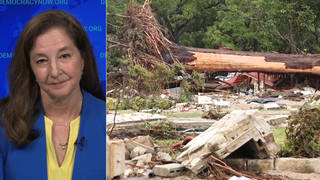
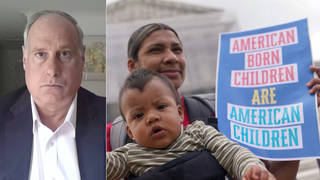
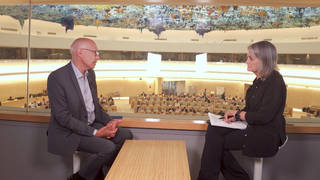
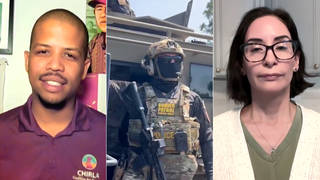
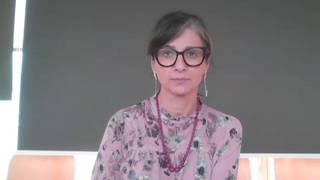
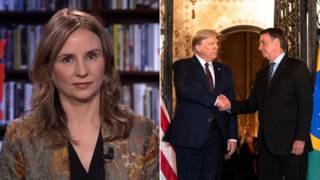
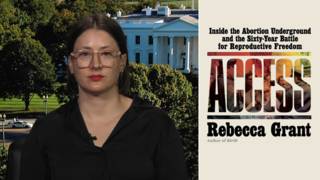



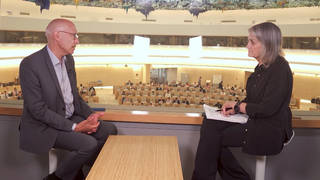
Media Options